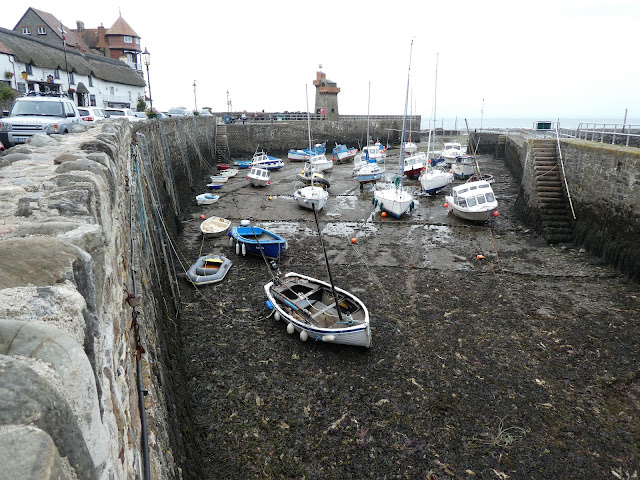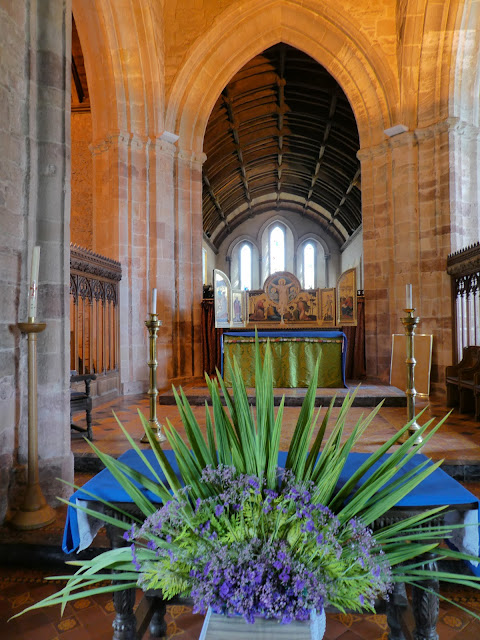The first five days of our South West Coast Path of England. Each day begins like this:
A fight with 'the monster'
Then a steep walk up from sea level through woods.Beautiful old pathways under green shade.
Then over the moors of Exmoor. Heather blooms. The moors and fields come right down to the cliff and cove-lined coast.
We have crossed Exmoor now, left the national park and this was all we saw of the famed wild Exmoor ponies.
Dramatic coastline. At times we can see all the way back to where we were the previous day.
You wouldn't want to trip over to the right. There's not much to stop you rolling all the way down.Local residents enjoying the sunshine.
Valley of the Rocks.
Pooh bear with his nose in a honey barrel, or an elephant with a swollen trunk.
There are tiny people down there on the beach.
As you can see, the sea is calm, just gently sighing onto the cliffs, the sky is blue and it is quite hot and humid. Not complaining about the dry weather and endless views, but 20, 24, 27 degrees with high humidity is a bit energy draining for us old princesses who don't like feeling all sweaty and sticky. Cooling our feet in a stream before climbing the steep side of Great Hangman.
At the top. We have been here before. Exactly 362 days ago, we stood here at the end of one adventure wondering what the next one would be, not dreaming we'd be back at the exactly the same place less than a year later!
Some quirky, cute, unexpected things we have seen.
A very very old barn still being used. Note the hay stored on a mezzanine under the roof.
Trees killed by sea water which floods these fields during very high tides. Our first night's accomodation at Porlock Weir in sight at the far end of the shingle beach which is horrible to walk on.Our room under the thatched roof just to the right of the chimney. A celebratory g&t was thoroughly enjoyed.
A curved toll house.
The track went through a series of short tunnels and arches that seemed to have no practical purpose.
Lichen arranged on a tiny window sill in the tiny St Buenos church nestled in thick forest at Culbone.
Mud, glorious mud - not! Churned up by tree felling machines of the Forestry Department for about a kilometre, liquid slush in places, got our new boots muddy!
My friend Casper just after he dived his nose straight into my lunch box. Lucky for me I had finished my sandwich. Apparently Casper is known for thinking the lunches of strangers are his.
Tide's out! Lynmouth harbour on our arrival. Our second night.
We did a 6km diversion from the path along a beautiful wooded river to Watersmeet Tea Rooms for whortleberry cream tea which was shared with the local birds.
Lynmouth (at sea level) is connected to Lynton at the top of the cliff by a water powered railway built in 1888. It is very steep and yes, we rode up in it.
After a very strenuous walk to Heddon Valley which consists of 2 hotels and a National Trust shop surrounded by walking trails, we discovered our hotel was the one another mile up a steep road. But we were greeted by a gracious 1920s building, lovely friendly hosts and tea and cake on the terrace. Felt like we were in an Agatha Christie novel, without the murder.
And a room fit for princesses, four times larger than the pretty but tiny room of the previous night which would have almost fitted in the bathroom here.
We saw Sir Rod Stewart just down the road from our b&b in Combe Martin.
Verity is a 20.25m tall, 25 tonne bronze statue representing truth and justice which stands on the wharf at Ilfracombe where we ended our fifth day of walking the Path.
Ilfracombe is an attractive harbour town with some very steep streets.
Did I tell you it is hot? 27 degrees and what feels like 100% humidity. And it is a Bank Holiday long weekend, the end of the school holidays, so the Brits are all at the beach.
Note- Some of these photos were taken by Sheryl. You can usually tell by the fact that I am in them.


































































